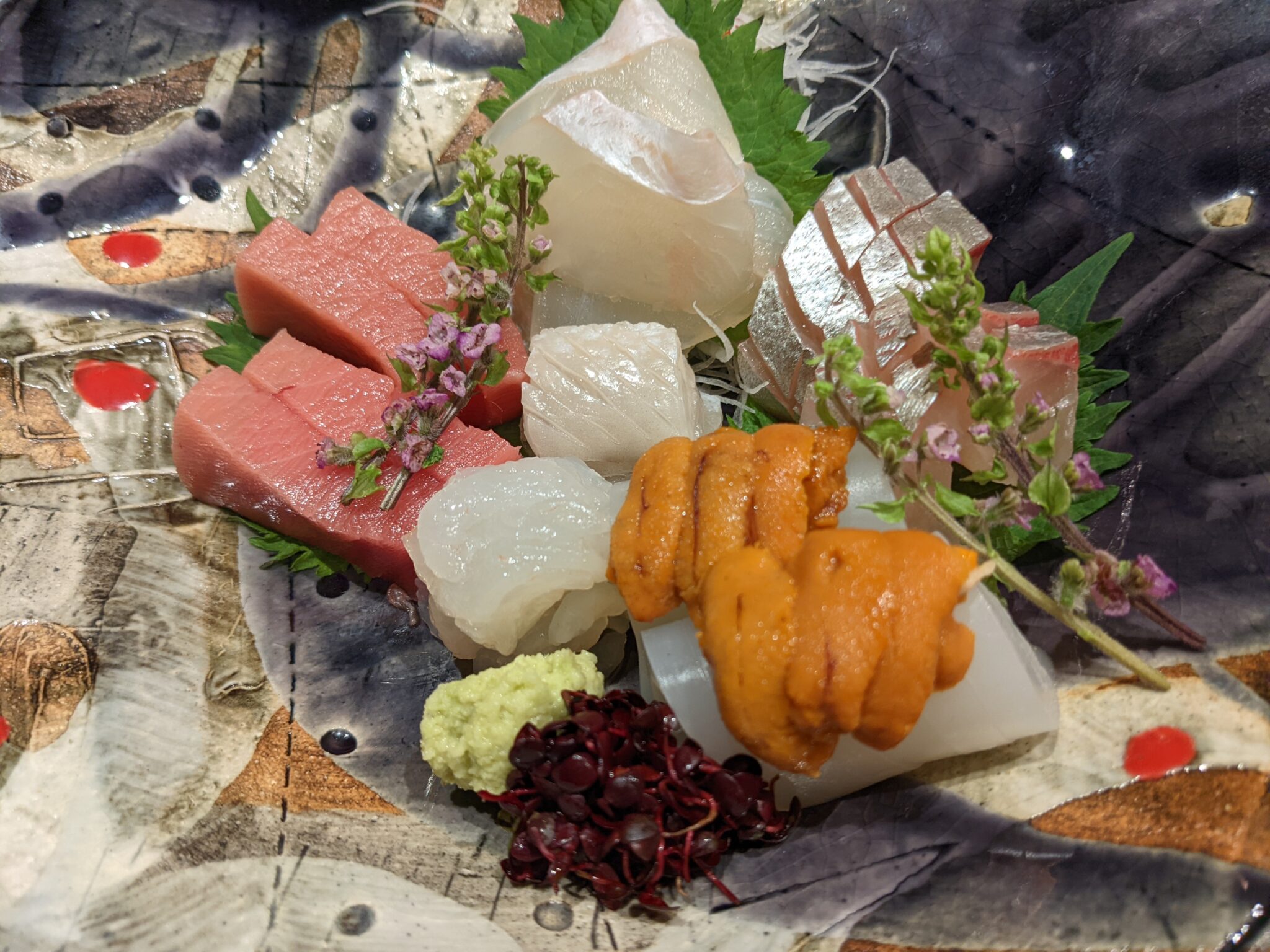KYOTO DINING
This past weekend my wife and I decided to go down to Kyoto to celebrate the 2682nd anniversary of the birth of Japan. At least according to the ancient histories. The trip was actually more about taking advantage of the current dearth of foreign tourists and an opportunity to try out some restaurants for the first time. And for my wife, a chance to do hakamaeri (visiting her parent’s graves). She easily made reservations at two places just a couple days before going, something that would have been impossible in pre-corona times. So, Friday morning, in the middle of watching the Men’s Halfpipe event of the Winter Olympics, off we went.
We traveled light, just one small suitcase and my PC in my backpack. Actually, I packed too light, as I neglected to bring along a scarf/muffler, and the charger for my PC. Oops. But no problem as I found a new muffler in Kyoto for only ¥1,500, although it was so warm I really didn’t need it. We checked into our hotel around 3:00, three hours before our dinner reservation at Nihonryō Tokuwo (日本料理とくを). We killed the time before dinner sipping a couple of beers and watching Olympic highlights in our room, and then walked down towards the restaurant, ten minutes or so away.
The restaurant was just south of Shijō Dōri on the west side of Kamogawa (river). There were several large bouquets of flowers in front from other restaurants or regular customers marking the 17th anniversary of the restaurant, a cultural custom that seems to be unique to Japan. We were seated at the far-left side of the eight-seat counter—six seats on our side and two more around the corner. The four corner seats, the ones closest to the owner/chef, appeared to be occupied by regular customers, while the two on my right by first timers like my wife and me. There were two bottles of champagne on the back counter wrapped together the way bottles of sake are given to shrines, especially for matsuri (festivals), the bottles most likely from one of the regular customers there that evening. When my wife made the reservation she asked for ala carte, rather than a course that included beef. After taking a look at the menu I knew she had made the right call.
We started with a plate of sashimi which consisted of hirame with engawa; hon-maguro; shima aji; ama-ebi; and ika topped with a large spoonful of uni. There was salt for the ebi, while the rest were eaten with fresh wasabi. The menu was written by hand, which made deciphering some of the Kyoto names for dishes a bit of a challenge for me, but I managed to order a dish of ebi imo topped with a fresh crab simmered in a kudzu sauce (excellent!) while my wife ordered a kamo manju (again, excellent), both dishes availbe only in the winter. Next came nodoguro fry, made with a very fine panko, guji (Kyoto name for amadai) grilled over charcoal grill behind the counter directly in front of us), a serving of ankimo, some takenoko gohan, and for dessert, miso ice cream. Total: ¥29,980, which included three different sakes.
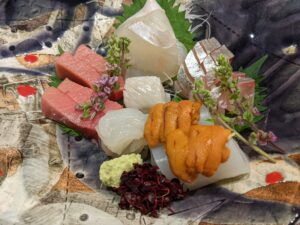
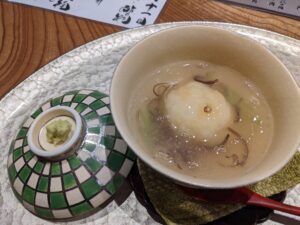
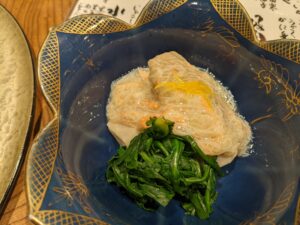
One of the regular customers ordered some sort of beef dish, which was interesting to watch be cooked. First Tokuwo san pulled a huge, maybe three kilo, piece of meat out of the cooler, then sliced off a third or so of it before paring the excess fat off. Then it was skewered and placed on the grill high above the hot charcoal where it slowly cooked for perhaps twenty minutes, occasionally being repositioned so it could cook evenly. Even though I don’t eat beef, I was nonetheless quite impressed by the process.
Due to corona pandemic restrictions, our meal was finished early. It still being only 9:00, we looked for someplace to get a drink while walking back to our hotel. Most places were closed, but when we reached our hotel we noticed a place just across the street was open. There were quite a few bouquets of flowers in front, a sign the business had just recently opened. When we went in we were the only customers, at least on the first floor. I ordered a regular highball, and my wife a shōchū with soda. Pretty soon a few more customers came in. Standing at the table behind us was a young couple who ordered red wine highballs, something I had never heard of or seen. It was basically half a glass of red wine from Yamanashi and soda water, with aa bit of ice. Pretty soon two young women who had been working upstairs came down, both carrying the same wine sours. Naturally, when I finished my drink I ordered a wine sour, just out of curiosity. It turned out to be very good. Sort of like the old wine spritzers that were sold in single drink bottles a long time ago, only without all the added sugar. I have yet to see anyone drink one of these in Tokyo.
Nihonryōri Tokuwo 日本料理とくを
Kyoto Prefecture, Kyoto City, Shimokyo-ku, Kiya-dori Bukkōji noboru Ten-nōchō151
京都府京都市下京区木屋町通り仏光寺上る天王町151
https://tabelog.com/kyoto/A2601/A260201/26004751/
075-351-3906
Saturday
We started Saturday with a visit to Ginkakuji, going mostly by bus from Sanjōbashi. Ginkakuji was almost deserted, something I had never experienced. No crowds, despite it being a very fine day, sunny and not at all in the least bit cold. We hiked up to the top of the hill, something I had never done before due to the grounds being too crowded. From there we headed towards the Kamogawa river to eat lunch. On the way, very close to Ginkakuji, on the street approaching the temple, we passed Nakahigashi (中東), a shōjin ryōri restaurant my wife said was famous but a place she had never been able to go to. She then said that the restaurant we were heading to, So Kawahigashi, was related to Nakahigashi, the “So” in the name meaning “annex.”
We arrived at the restaurant on foot just before last order for lunch, although that was not a problem. We each ordered a beer, me an IPA, my wife a weizen, both from Rydeen, Hakkaisan’s beer label, and selected which type of glass we wanted to drink from. I ordered the “morning killed” chicken, and my wife the kinmeidai kara-age, and a serving of maguro to snack on while we waited for our mains.
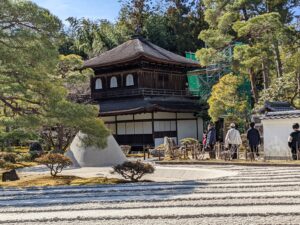
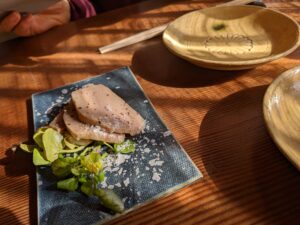
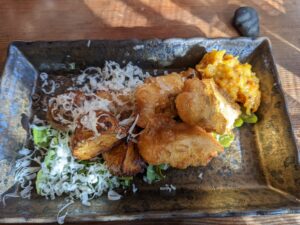
A couple minutes after we opened our beers the maguro arrived. It was three slices of maguro that had been simmered, served over greens and sprinkled with a mix of a very fine, and mild salt from Hiroshima mixed with rice flour. The salt mix alone went well with the beer, almost like eating a pretzel washed down with a beer. Next came servings of nanohana over abura-age; simmered daikon with konbu; my chicken, grilled and covered with a pile of katsuobushi shavings with grilled naganegi on the side, then my wife’s kinmedai kara-age, with grilled potatoes and a mild yellow salsa-like concoction; then miso soup served with house made bettara (a type of pickle) made with a uncommon variety of daikon, grown by owner’s grandmother in Sado-ga-jima island (Niigata); and finally some fruit, served on dishes that looked very familiar.
There was an interesting selection of beverages, including several bottles of all kōji nihonshu, lots of Japanese made craft gin, and some whisky. And of course there was tea, even a tea tasting course.
Our main items were served on musubi plates, plates that resembled a knot one might see on a men’s obi and representing tying people together. I said they looked just like a plate we were served on recently at Sushi Sugita, plates that were made by the customer on my left that evening. When I looked at my photos from Sugita that day I saw that the plates were indeed identical. Namihira san, the owner, said his were a gift from someone in Nara but thought the artist was from Hiroshima. When he pulled out the wooden box they came in we saw that the name was Arimoto Kūgen (有本空玄), the same as Sugita’s ceramicist customer. Small world. Namihira san was well aware of Sushi Sugita despite never having been there, and only wishing there was a way to make a reservation.
So Kawahigashi そ かわひがし
Kyoto Prefecture, Kyoto City, Sakyo-ku, Higashi Maruta-chō 18-5
京都府 京都市左京区 丸太町通川端東入ル東丸太町18-5
https://tabelog.com/kyoto/A2601/A260302/26033217/
That evening we weren’t very hungry, especially not by 7:00 when we would probably need to already have started eating under the pandemic restrictions. We called one place I had been to before to check how late they were open, and they said last order at 10:00. So around 7:30 we walked across the Kamo River to Akagaki-ya (赤垣屋) to see if we could get in as they said walk-in seating at the counter was okay. When we arrived, however, they said they were full, despite two empty seats at the counter. So back towards the hotel we went, looking for pretty much anyplace that was open at the ridiculously early hour of 8:00 pm. We ended up getting a take-out pizza from Salvatore, a chain with an outlet a couple of blocks from home. It seemed like a waste to be eating pizza in Kyoto, but it turned out to be just what we needed.
Sunday
When we woke up it was looking like it was going to rain soon, so we stayed in our room and watched Olympic highlights until it was time to check out. We had our one suitcase sent to the Kyoto Station so we wouldn’t need to drag it around in the rain, then walked across the river to Sanjōbashi Station to catch a subway down to Gojō, emerging from the station into a light rain. My wife wanted to go visit her parents’ grave a few hundred meters to the east, but I convinced her that if we went then that we would be late for lunch. It turned out to take a bit longer to reach the restaurant than we had thought, so waiting to visit the grave until after lunch was the right decision.
We arrived a few minutes early, but were quickly ushered inside and out of the rain by a woman we believe was the chef/owner’s wife. We were seated at the far end of the seven-seat counter, the first to arrive. Soon an older couple who seemed to be friends with the owner were seated next to us, and finally another couple at the far end, with one empty chair next to them on their left.
We ordered a tokuri of sake, then waited for the food to start flowing. First up was a small fish deliciously grilled over charcoal with some very thin grilled naganegi. The fish was moroko, a freshwater fish from Lake Biwa, and a first for me to eat. Next came more fish, this time covered in served in a beautiful gold and black urushi (lacquer) bowl with inlaid images of birds flying, the fish in a clear soup with a tiny daikon with greens on top. Then came hirame, the sashimi cut from a large (3 kg) fish and served on Oribe-style dishes.
At least our dishes were Oribe-style. The couple next to us had very simple looking and very old plates which, after being wiped clean, were handed to me and my wife to look over. The plates were grey and brown with a sketch of what looked like asters standing alone, with a couple of spots of gold paint where the plate had once needed repairing. We got the sense that my next-door neighbor was either a porcelain artist or scholar as he and the owner not only kept talking about the dishes but he also pulled out some he had brought along.
Next came goma-miso mochi topped with a small piece of tenpura fukinotō, a spring mountain vegetable (sansei) served on a simple brown plate; a thick piece of karasumi served on top of sushi rice nigiri-style, this time on a Chinese-style plat from the Edo period; grilled guji (amadai) on a brown plate with pictures of birds and sedges; and akagai, served in a small porcelain cup. When we ordered another round of sake it came in a small bird-shaped pot with a chicken head spout to pour from. The ochoko I picked this time was white with a picture of a crab on the bottom., a good choice as crab soon followed. Our final sake was served in an old delft-style pot with emblazoned with the ‘Z’ mark that was a symbol of the old Dutch East India Company.
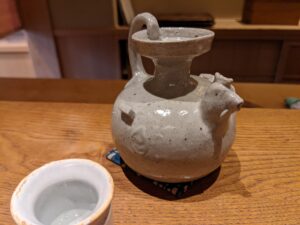


The tenpura course was lightly battered ama-ebi and zenmai (spring fern) topped with something that was new to me; grated dried egg yolk. To make this, egg yolks are lightly sprinkled with salt and sugar, then dried in an oven at low heat. Then they are grated, as with parmesan cheese. Very interesting, and creative. Next came the crab, one of my favorite foods and something that is outrageously expensive this year. The crab was topped with a soft egg omelet of sorts, and was one of the highlights of the meal for me.
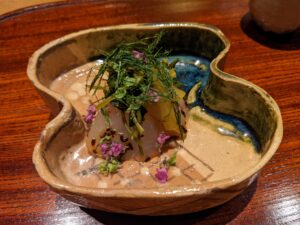
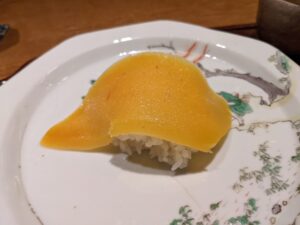
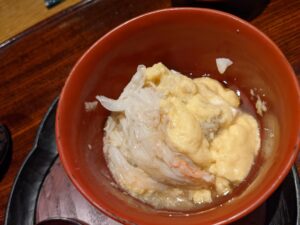
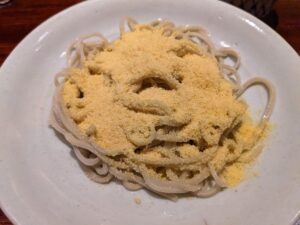
What came next was a pleasant surprise, something I don’t think I had ever eaten at a high-end rest4aurant, especially in Kyoto: a plate of soba, the ceramic plate custom made for the restaurant with holes in the bottom to drain off excess water, making it a type of seiro, I guess. The soba was ni-hachi, meaning eight parts soba and two parts wheat flour, and was topped with the same grated dried egg yolk as we had earlier. When the tsukemono (pickles) were set in front of us we knew it was time for the gohan course. The tsukemono had some konbu on one small plate and more traditional nukatsuke kyūri (cucumber), okura (okra) and daikon, while the rice was served Kyoto style; one small bite at first, followed by as much as you wanted in the bowl, plus a bowl of white miso soup.
The meal concluded with some fruit and a bowl of macha with a piece of monaka that had been slowly toasting over a small charcoal brazier off to the side behind the counter. The meal was very much influenced by tea ceremony culture, especially the way the dishes (the ceramics) were brought out for use and then wiped clean to be looked over and admired by the guests, just as is done with tea equipment during tea ceremony. I have no idea if this was normal or if it had been done that particular day thanks to the presence of the “sensei” seated next to me. Either way, it was easy to see how Godan Miyazawa has a Michelin star.
And about the vacant seat; One hour into the meal, at exactly 1:00, a single woman entered the room and took the seat. Judging by her lack of apologizing for being late, it seemed that she had a 1:00 start time.
Godan Miyazawa ごだん 宮ざわ
京都市下京区東洞院通万寿寺上ル大江町 557
Kyoto City, Shimogyō-ku, Ōechō 557
https://jiki-miyazawa.com/#godan
075-708-6364
Tea Pairings:
I’m not sure if this is something that began under recent corona related restrictions on dining and drinking, but both So Kawahigashi and Gotan Miyazawa offered tea pairings or tea tastings. And customers were drinking them, one person along with a beer. At one meal last year we were served a course of teas from Taiwan, both hot and cold. It was actually kind of fun, and a good way to be introduced to teas I might otherwise never drink or even be aware of. But still, wine or sake or even a beer would have been preferred.
